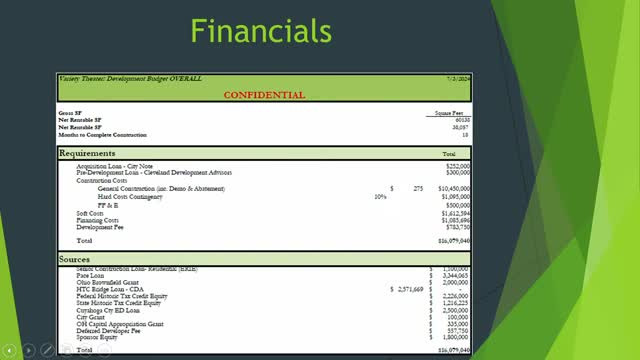Cleveland's historic theater set for major redevelopment
July 09, 2024 | Cuyahoga County, Ohio

This article was created by AI summarizing key points discussed. AI makes mistakes, so for full details and context, please refer to the video of the full meeting. Please report any errors so we can fix them. Report an error »

In a recent government meeting, discussions centered around the redevelopment of a historic entertainment facility, with stakeholders emphasizing the potential economic impact and community benefits of the project. The initiative aims to transform a long-neglected theater into a vibrant live entertainment venue, drawing on successful models from similar past projects.
The project’s proponents acknowledged the inherent risks, noting that it may take two to three years before the facility begins generating significant returns for equity investors. Despite these challenges, they expressed optimism, estimating a 60-40 likelihood of achieving the projected financial outcomes based on current pro forma analyses.
One key speaker, who previously operated a successful live music venue, shared insights from their experience in revitalizing a community space in Lakewood, Ohio. They highlighted the transformative effect such projects can have on local neighborhoods, citing a dramatic increase in property values and commercial development in the area over the past decade.
The redevelopment plan emphasizes preserving the theater's original structure, built in 1927, and restoring it to its intended purpose as a vaudeville and movie theater. The project includes a robust community engagement strategy, particularly with the Cleveland Municipal School District, to ensure that local arts programs can utilize the space for educational purposes.
Stakeholders reiterated their commitment to making the project a community asset, with plans in place to ensure financial sustainability and accountability for public funds invested in the restoration. While the timeline for profitability remains uncertain, the focus on community involvement and historical preservation underscores the project's potential to enrich the cultural landscape of Cleveland.
The project’s proponents acknowledged the inherent risks, noting that it may take two to three years before the facility begins generating significant returns for equity investors. Despite these challenges, they expressed optimism, estimating a 60-40 likelihood of achieving the projected financial outcomes based on current pro forma analyses.
One key speaker, who previously operated a successful live music venue, shared insights from their experience in revitalizing a community space in Lakewood, Ohio. They highlighted the transformative effect such projects can have on local neighborhoods, citing a dramatic increase in property values and commercial development in the area over the past decade.
The redevelopment plan emphasizes preserving the theater's original structure, built in 1927, and restoring it to its intended purpose as a vaudeville and movie theater. The project includes a robust community engagement strategy, particularly with the Cleveland Municipal School District, to ensure that local arts programs can utilize the space for educational purposes.
Stakeholders reiterated their commitment to making the project a community asset, with plans in place to ensure financial sustainability and accountability for public funds invested in the restoration. While the timeline for profitability remains uncertain, the focus on community involvement and historical preservation underscores the project's potential to enrich the cultural landscape of Cleveland.
View full meeting
This article is based on a recent meeting—watch the full video and explore the complete transcript for deeper insights into the discussion.
View full meeting
